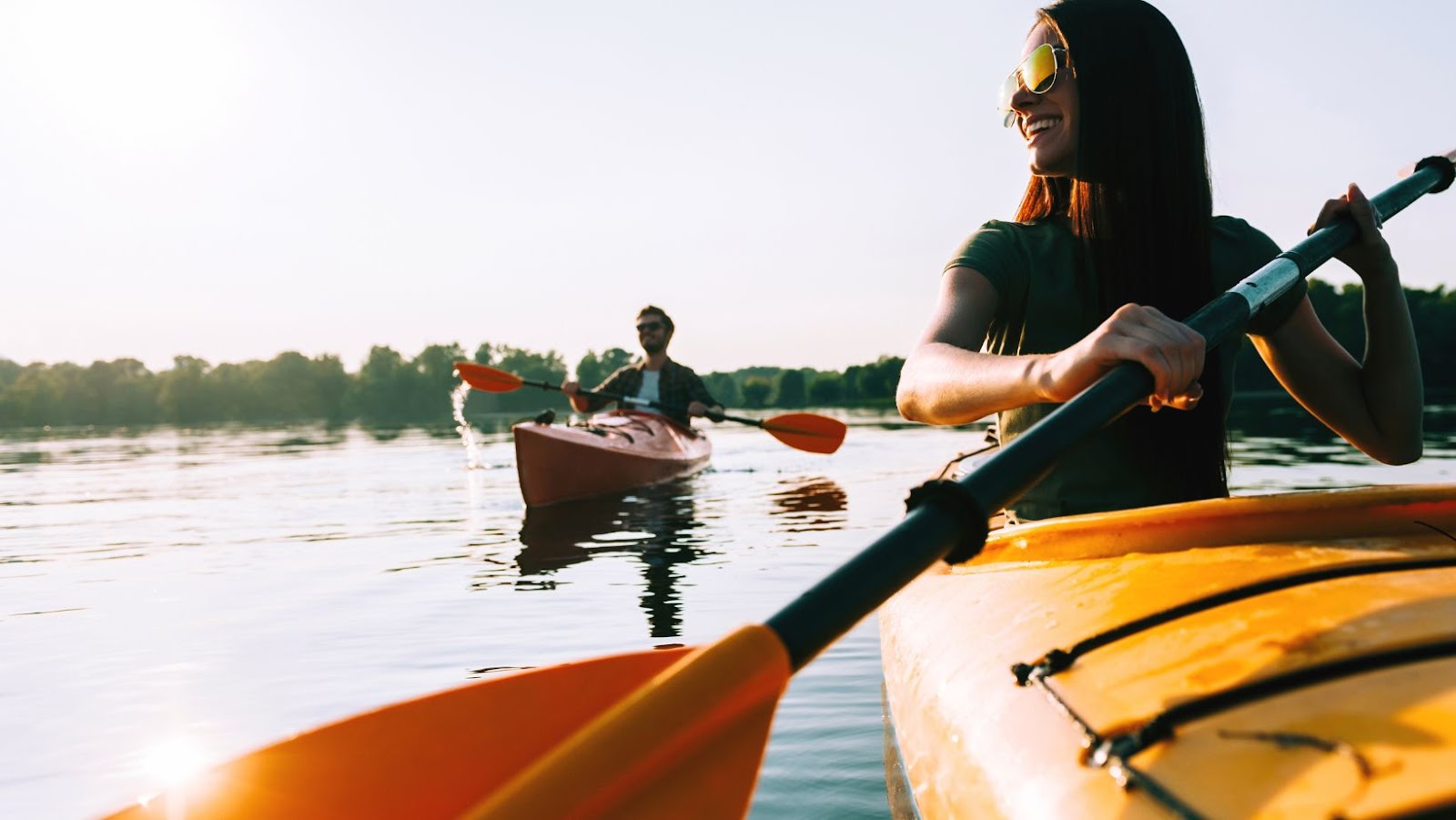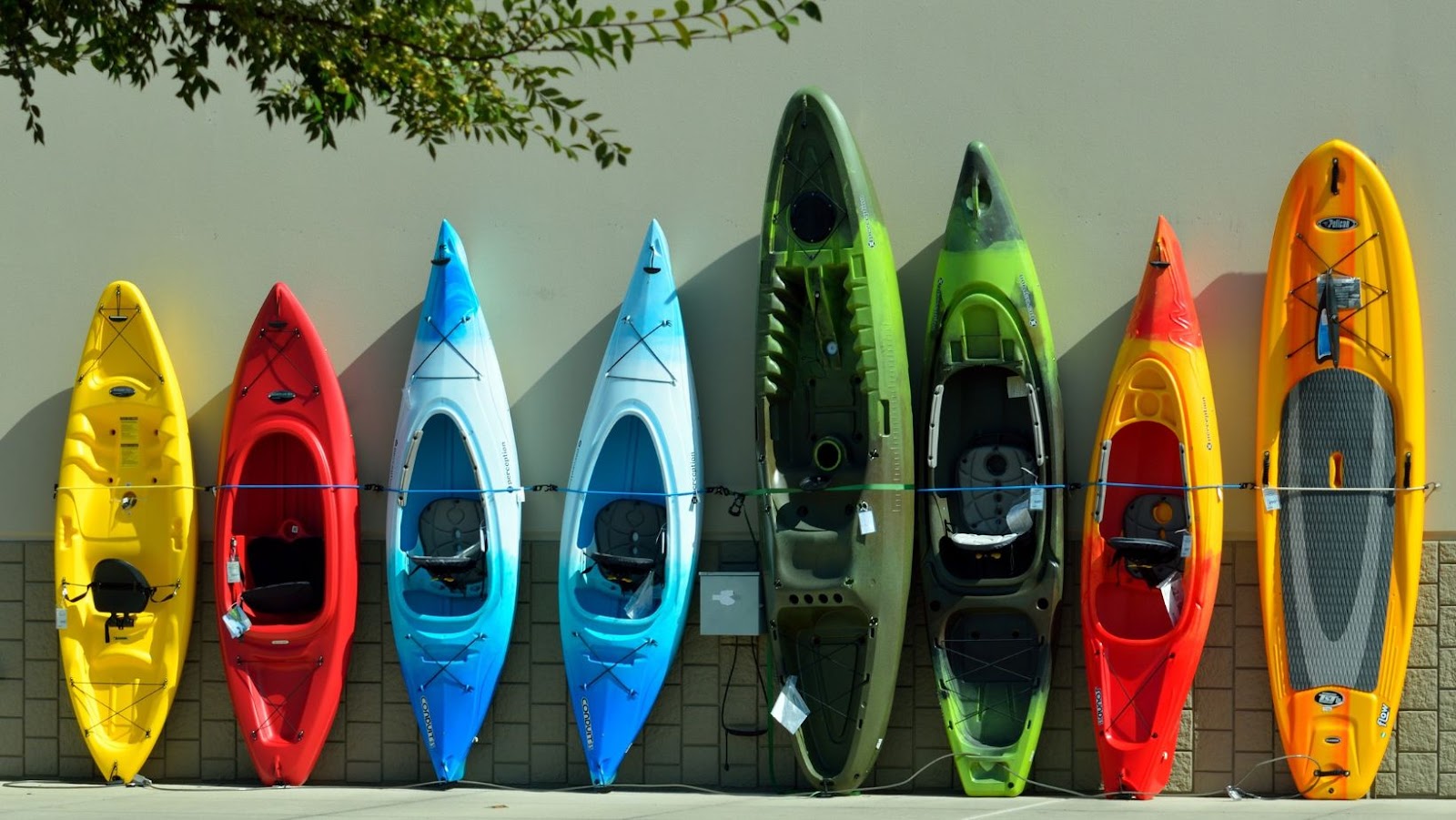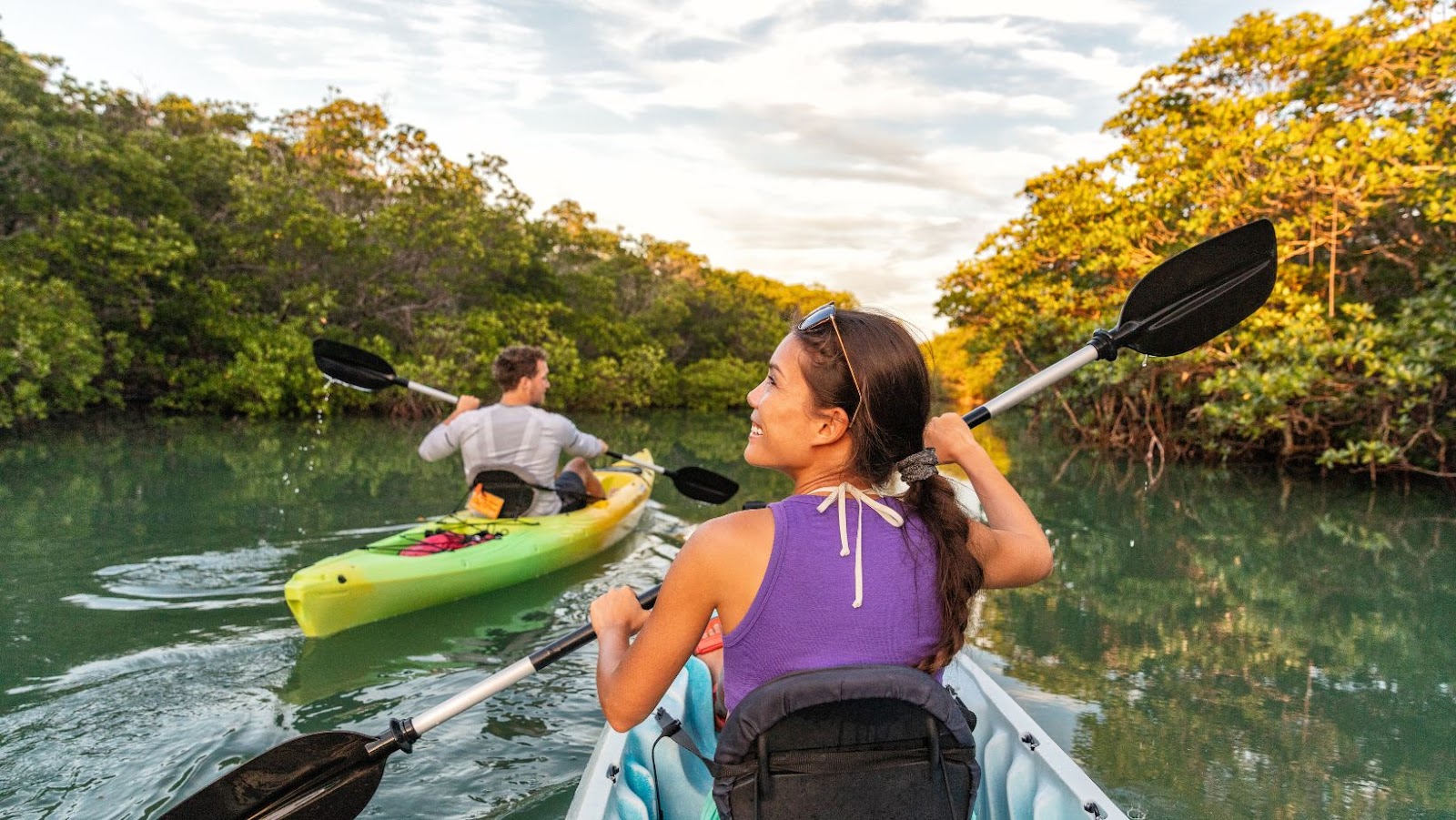
Whether you’re kayaking for leisure or engaging in the sport professionally, it’s important to wear the right clothing. You might think that any clothes will do when going out to kayak, but wearing the wrong clothes can be uncomfortable and even dangerous. Cotton is one material that experts recommend avoiding altogether: it absorbs water quickly, which rapidly reduces its insulating properties and can make you colder.
Here are other tips on what to wear when kayaking to help keep you comfortable and safe while enjoying a fun paddling experience.
What to Wear While Kayaking
When kayaking, it is important to choose the right clothing. Cotton is not a good choice when kayaking due to its absorbent properties. Choosing clothing made of fabrics such as polyester or nylon instead is a much better option as they are more water resistant and will keep you dryer and warmer during your kayaking trip.
Let’s explore the options for what to wear when kayaking.
Wetsuit
Wearing a wetsuit is the optimal choice for kayaking. A wetsuit will not only provide insulation, but also abrasion resistance. The type of wetsuit you need depends on the climate. In warm areas, you can opt for a 1/4 – 3/4 length compressor board shorts and shirt, while in cold areas a full-length wet suit is advised.
If you plan to kayak in cold water, be sure to choose a suit with high stretch and warmth factors, as well as an appropriate thickness with appropriate seals at the neck, wrists and ankles to prevent water flushing. A hood may also be necessary depending on how cold the water is or how often you are likely to capsize.
For added protection against the sun while playing in open water, consider adding a rashguard or neoprene gloves and boots.
Drysuit
A drysuit is a vital piece of equipment for kayakers heading out in cold or wet conditions. Made from a waterproof and breathable fabric, the drysuit completely encloses the body and arms to keep them dry during long paddling sessions. Drysuits are designed with an adjustable neck entry and closures at the wrists, ankles and waist to ensure water can’t get inside. Depending on the model of drysuit you choose, they may also feature zippered pockets, waterproof braces or even suspenders.
Choose a drysuit based on its construction materials and design features that best suits your needs. Breathable fabrics such as GORE-TEX® can provide an extra layer of insulation, while latex gaskets at key closures keep water out by conforming to the shape of your body with continual use. Neoprene offers greater mobility but is not fully waterproof when used kayaking in cool weather. It’s important to factor in whether you need additional insulating layers beneath the suit too – inner insulation such as fleece or wool may be required for extreme conditions.
Finally, avoid cotton fabrics when choosing a kayaking outfit; As cotton does not provide adequate thermal protection in wet environments, quick-drying synthetics like polypropylene or polyester should always be your go‐to materials if you plan to stay warm and comfortable on cooler paddles outings!
Rash Guard
Rash guards are a must for any type of kayaking expedition, especially if you are going to be out on the water for an extended period of time. A rash guard is a type of clothing specifically designed to protect you from rashes, sunburn and other skin irritations that can occur while you’re out on the water. It is typically made from a spandex-blend fabric that stretches with every move and is highly breathable, which helps to wick away moisture and keep your skin dry.
Rash guards come in various styles such as long-sleeved T-shirts and zip-up onesies that can help protect your arms and torso from exposure to the sun or abrasions on the kayak. They are also available in different colors and designs so you can choose one that expresses your personality. Look for one that fits securely yet allows for freedom of movement. This will keep you comfortable and free from discomfort when paddling through rapid waters or maneuvering around obstacles.
Neoprene Boots
When kayaking, neoprene boots are a great option to keep your feet protected. They provide the needed insulation against the cold water and have a very good grip on slippery surfaces. They also help to reduce potential injuries when you come in contact with rocks and other obstacles.
For colder temperatures, choose thick-soled boots for greater insulation; if it’s hot outside, go for thinner soles with breathable fabrics.
Moreover, neoprene boots offer ample ankle support and are ideal for boats or fishing trips in which passengers will be standing up for most of the journey. If you’re expecting more intense activity while kayaking, consider using an adjustable heel that can be moved upwards to facilitate quick transitions between sitting and standing while wearing the boots.

Lastly, it is essential to find a pair of neoprene boots that fit comfortably on your foot, allowing you to move around without feeling constrained or restricted.
Neoprene Gloves
When kayaking, you should always wear a personal flotation device (PFD). You should also try to wear clothes that are designed to keep you warm, even when they get wet. Neoprene gloves provide a great option for keeping your hands warm while you’re out on the water.
Neoprene is a synthetic material made up of tiny fibers of polyester and nylon mixed with rubber, which makes it waterproof and windproof. A pair of neoprene gloves or mittens will help keep your hands warm and dry in all kinds of weather conditions.
Neoprene gloves are available in different thicknesses so you can choose the ones that best fit your climate and needs. Keep in mind that thicker gloves tend to be more waterproof than thinner ones. It’s also important to make sure that your gloves fit properly — one size too large means that water can enter easily through the wrist opening; one size too small will restrict movement and cause discomfort. A good pair of neoprene gloves can mean the difference between an enjoyable kayaking experience and an uncomfortable one!
Benefits of Wearing the Right Clothes
No matter what your level of experience, it’s important to wear the right clothing when you go out kayaking.
Wearing specific materials can help protect you from the elements and improve your performance on the water. In this article, we’ll discuss the benefits of wearing the correct clothing when kayaking, and why you should avoid cotton.
Keeps You Warm
When kayaking, it is important to wear the appropriate clothing for the weather and water conditions that you are paddling in. This is to avoid feeling cold, wet, or uncomfortable throughout your session. A wide range of materials are available for different activities, from wetsuits and rash guards to fast-drying fabrics.
Depending on the temperature and expected length of your kayaking trip, a wetsuit could be an ideal option. Wetsuits are perfect for cold-water kayaking as the material keeps your whole body warm and allows for maximum freedom of movement. Generally made from neoprene, these suits provide flexibility while also allowing a small amount of water to enter between you and the suit. This will act like insulation, trapping a thin layer of water next to your body which will then provide warmth while out on the water. Alternatively drysuits are available which keep you completely dry but can expel air through one-way valves located in certain areas on the suit and prevent overexposure should you capsize or take a swim!
For warmer climates other fabrics could be more suitable such as lightweight breathable materials like spandex or heavy gauge polyesters with NanoTex coatings which offer superior moisture management features allowing quick evaporation of sweat faster than cotton – an important factor when participating in endurance activities such as sea kayaking! A good rule to remember when picking your clothes is not to opt for cotton as any items made from this material absorb moisture easily making those items cold and heavy!
Protects You from the Elements
When going out kayaking, it’s important to dress properly to protect yourself from the elements. Wearing the right clothes will make sure that you can enjoy your recreational kayaking experience without worrying about getting too cold, too hot or too wet. Here are some of the benefits of wearing the right clothes when kayaking:
● Protection from Wind and Water: Most experts recommend avoiding materials such as cotton and denim when going out for a day in a kayak, because these materials tend to absorb a lot of water, making them heavy and uncomfortable. Lightweight synthetic materials are more suitable for this kind of activity as they offer protection against wind and light rain while keeping you dry and warm. They also dry quickly if they get wet.
● Improved Comfort: One of the problems with wearing cotton is that it gets stiff when wet and tends to bunch up around your neck, wrists or waist —which can be very uncomfortable if you’re spending several hours paddling in choppy waters. Synthetic fabrics such as nylon or spandex are designed specifically for activities like kayaking, providing better comfort even during long trips on the water.
● Added Sun Protection: Kayakers who spend extended amounts of time out in direct sunlight should consider wearing clothing with sun protection factors (SPF) built in. This type of clothing is specially designed to shield skin from harmful UV rays while allowing moisture to escape through special fabric technologies —protecting your skin but also cooling you down at the same time!
Increases Visibility
When kayaking, having visibility is an important factor in ensuring a safe and successful journey. Choosing the right clothing can significantly contribute to your visibility and ensures that you are seen by other boats, hikers on shore, or emergency rescue personnel, if needed.
Wearing more visible colors such as bright yellows, oranges or pinks makes it possible for you to be seen from a greater distance—helping to keep both you and your fellow paddlers safe as you explore new waters. Additionally, safety vests typically have reflective strips which help other boaters see the lights on your boat—especially during dawn or dusk when the sun is low. Wearing these in addition to bright colors can help keep yourself easily visible during all times of day.
In conclusion, the most important thing to consider when choosing what to wear when kayaking is comfort and safety. It’s best to wear comfortable synthetic or wool-based fabrics that wick away moisture and can dry quickly if it does get wet. Light layers of clothes are best for variable temperatures, and a hats and sunglasses will protect you from the sun. Be sure to wear shoes with good grip in case you need to get out of the kayak in shallow water or rapids (waterproof sandals work best).

Lastly, make sure any lifejackets you wear fit properly so that they don’t impede your mobility or slip off in case of a capsize. With these tips, you’ll be prepared for kayaking adventures of any type – whether that means exploring a serene lake or adrenaline-filled white water rapids!




